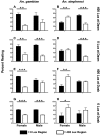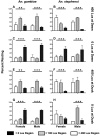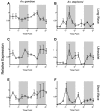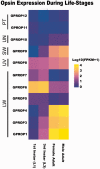Crepuscular Behavioral Variation and Profiling of Opsin Genes in Anopheles gambiae and Anopheles stephensi (Diptera: Culicidae)
- PMID: 26334802
- PMCID: PMC4445134
- DOI: 10.1093/jme/tjv024
Crepuscular Behavioral Variation and Profiling of Opsin Genes in Anopheles gambiae and Anopheles stephensi (Diptera: Culicidae)
Abstract
We understand little about photo-preference and the molecular mechanisms governing vision-dependent behavior in vector mosquitoes. Investigations of the influence of photo-preference on adult mosquito behaviors such as endophagy and exophagy and endophily and exophily will enhance our ability to develop and deploy vector-targeted interventions and monitoring techniques. Our laboratory-based analyses have revealed that crepuscular period photo-preference differs between An. gambiae and An. stephensi. We employed qRT-PCR to assess crepuscular transcriptional expression patterns of long wavelength-, short wavelength-, and ultraviolet wavelength-sensing opsins (i.e., rhodopsin-class G-protein coupled receptors) in An. gambiae and in An. stephensi. Transcript levels do not exhibit consistent differences between species across diurnal cycles, indicating that differences in transcript abundances within this gene set are not correlated with these behavioral differences. Using developmentally staged and gender-specific RNAseq data sets in An. gambiae, we show that long wavelength-sensing opsins are expressed in two different patterns (one set expressed during larval stages, and one set expressed during adult stages), while short wavelength- and ultraviolet wavelength-sensing opsins exhibit increased expression during adult stages. Genomic organization of An. gambiae opsins suggests paralogous gene expansion of long wavelength-sensing opsins in comparison with An. stephensi. We speculate that this difference in gene number may contribute to variation between these species in photo-preference behavior (e.g., visual sensitivity).
Keywords: Anopheles gambiae; Anopheles stephensi; crepuscular behavior; photopreference; rhodopsin.
© The Authors 2015. Published by Oxford University Press on behalf of Entomological Society of America.
Figures





Similar articles
-
Retention of duplicated long-wavelength opsins in mosquito lineages by positive selection and differential expression.BMC Evol Biol. 2017 Mar 21;17(1):84. doi: 10.1186/s12862-017-0910-6. BMC Evol Biol. 2017. PMID: 28320313 Free PMC article.
-
The Seasonality and Ecology of the Anopheles gambiae complex (Dipetra: Culicidae) in Liberia Using Molecular Identification.J Med Entomol. 2015 May;52(3):475-82. doi: 10.1093/jme/tjv003. Epub 2015 Mar 16. J Med Entomol. 2015. PMID: 26334824
-
Cloning, characterization, and expression of microRNAs from the Asian malaria mosquito, Anopheles stephensi.BMC Genomics. 2008 May 23;9:244. doi: 10.1186/1471-2164-9-244. BMC Genomics. 2008. PMID: 18500992 Free PMC article.
-
Diel changes in the expression of long wavelength-sensitive and ultraviolet-sensitive opsin genes in the Japanese firefly, Luciola cruciata.Gene. 2009 May 1;436(1-2):66-70. doi: 10.1016/j.gene.2009.02.001. Epub 2009 Feb 13. Gene. 2009. PMID: 19232386
-
A cure for the blues: opsin duplication and subfunctionalization for short-wavelength sensitivity in jewel beetles (Coleoptera: Buprestidae).BMC Evol Biol. 2016 May 18;16(1):107. doi: 10.1186/s12862-016-0674-4. BMC Evol Biol. 2016. PMID: 27193495 Free PMC article.
Cited by
-
The transcriptome of the mosquito Aedes fluviatilis (Diptera: Culicidae), and transcriptional changes associated with its native Wolbachia infection.BMC Genomics. 2017 Jan 3;18(1):6. doi: 10.1186/s12864-016-3441-4. BMC Genomics. 2017. PMID: 28049478 Free PMC article.
-
Daily Rhythms in Mosquitoes and Their Consequences for Malaria Transmission.Insects. 2016 Apr 14;7(2):14. doi: 10.3390/insects7020014. Insects. 2016. PMID: 27089370 Free PMC article. Review.
-
Effects of circadian clock disruption on gene expression and biological processes in Aedes aegypti.BMC Genomics. 2024 Feb 13;25(1):170. doi: 10.1186/s12864-024-10078-8. BMC Genomics. 2024. PMID: 38347446 Free PMC article.
-
Evolution of an epigenetic gene ensemble within the genus Anopheles.Genome Biol Evol. 2015 Feb 26;7(3):901-15. doi: 10.1093/gbe/evv041. Genome Biol Evol. 2015. PMID: 25724208 Free PMC article.
-
Opsin1 regulates light-evoked avoidance behavior in Aedes albopictus.BMC Biol. 2022 May 13;20(1):110. doi: 10.1186/s12915-022-01308-0. BMC Biol. 2022. PMID: 35549721 Free PMC article.
References
-
- Ali A., Nayar J. K., Knight J. W., Stanley B. H. 1989. Attraction of Florida mosquitoes (Diptera:Culicidae) to artificial light in the field. 57th Annu. Conf. Calif. Mosq. Vector Control Assoc. Inc. Los Angeles, California, USA.
-
- Allan S. A, Day J. F., Edman J. D. 1987. Visual ecology of biting flies. Annu. Rev. Entomol. 32: 297–316. - PubMed
-
- Alonso P. L., Tanner M. 2013. Public health challenges and prospects for malaria control and elimination. Nat. Med. 19: 150–155. - PubMed
-
- Bentley M. T., Kaufman P. E., Kline D. L., Hogsette J. A. 2009. Response of adult mosquitoes to light-emitting diodes placed in resting boxes and in the field. J. Am. Mosq. Control Assoc. 25: 285–291. - PubMed
-
- Bray P. G., Mungthin M., Ridley R. G., Ward S. A. 1998. Access to hematin: The basis of chloroquine resistance. Mol. Pharmacol. 54: 170–179. - PubMed
Publication types
MeSH terms
Substances
Associated data
LinkOut - more resources
Full Text Sources
Other Literature Sources

